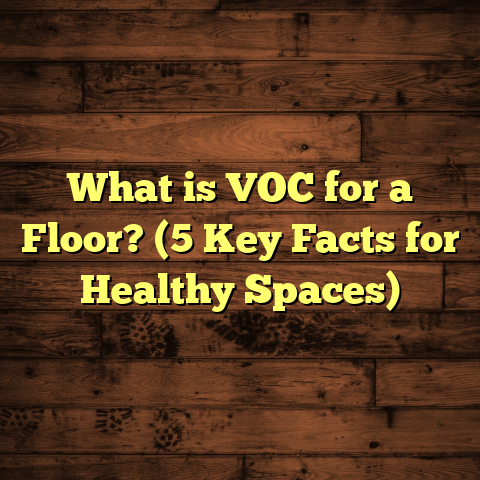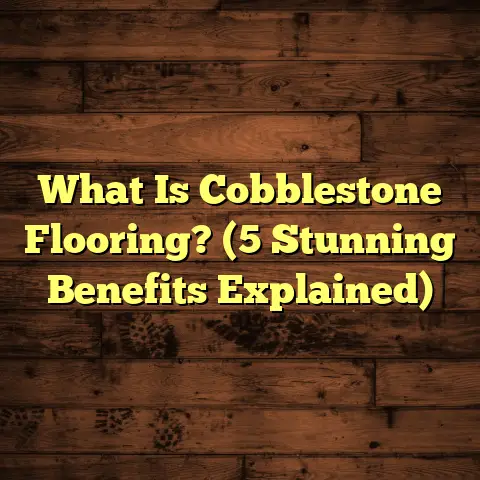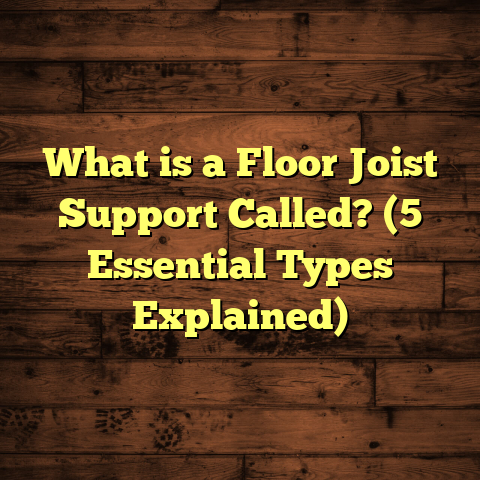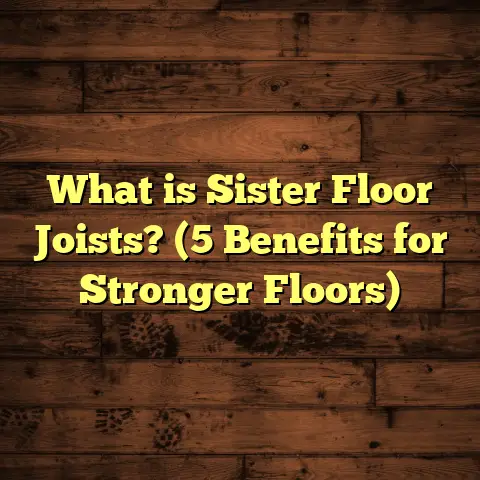What is Rigid Vinyl Plank Flooring? (5 Benefits You Need to Know)
Cost is one of the first things I think about when advising friends or clients on flooring options. Everyone wants a beautiful, lasting floor but without the sticker shock that comes with some materials. Over time, I’ve come to really appreciate rigid vinyl plank flooring because it balances cost and quality in ways that surprise a lot of people. If you’re curious about affordable flooring that doesn’t skimp on style or durability, this might be the perfect solution for you.
What Is Rigid Vinyl Plank Flooring?
When someone asks me, “What exactly is rigid vinyl plank flooring?” I like to break it down simply. It’s a type of vinyl flooring made up of several layers, with a solid core that makes it more stable and durable compared to traditional vinyl sheets or flexible vinyl planks. The “rigid” part refers to this solid core, which can be made from various materials like limestone composite or wood plastic composite.
This core sits beneath a printed design layer that mimics natural materials like wood or stone. On top of that, there’s a protective wear layer that guards against scratches, dents, stains, and fading from sunlight. The combination results in planks that look authentic but perform way better when it comes to wear and tear.
What really sets rigid vinyl plank flooring apart is how it combines luxury and practicality. Unlike traditional vinyl, which can feel soft and bendable underfoot, rigid vinyl planks provide a firm surface closer to real hardwood. That makes walking on it more comfortable and gives it a high-end feel without the cost or upkeep.
Breaking Down the Layers
To give you a clearer picture, here’s what’s inside a typical rigid vinyl plank:
- Wear Layer: This is the top transparent layer that protects the plank from scratches, stains, and fading. The thicker this layer, the more durable your floor will be.
- Printed Design Layer: This layer carries high-resolution images of wood grain, stone textures, or other patterns. It’s what gives the floor its realistic appearance.
- Rigid Core: This solid core provides stability and resistance to dents or bending. Most commonly made from limestone composite (LVT – luxury vinyl tile/plank) or wood plastic composite (WPC).
- Backing Layer: The bottom layer adds support and sometimes includes an attached underlayment for soundproofing and cushioning.
The solid core is what makes installation easier too—you’ll usually find click-lock systems that let you snap planks together without glue or nails.
Why Does This Matter?
In my experience, understanding what’s underfoot helps you appreciate the value of your flooring choice. A solid core means less warping from moisture or temperature changes, which solves problems many people have with traditional vinyl or laminate floors. Plus, this structure contributes to long-lasting performance even in high-traffic areas.
1. Cost-Effectiveness That Stretches Your Budget
Let me tell you about the moment I realized how budget-friendly rigid vinyl plank flooring really is. A client called me frustrated after getting hardwood quotes for their 1,200-square-foot living room and kitchen. The bids were sky-high—some close to $12,000 just for materials and installation. When I suggested rigid vinyl plank as an alternative, they were skeptical until I showed them real numbers.
On average, rigid vinyl plank flooring costs between $2.50 and $5 per square foot for materials. Installation typically runs between $1.50 and $3 per square foot depending on where you live and how complex the layout is. That means total installed cost falls in the range of $4 to $7 per square foot.
For that same 1,200-square-foot space, switching to rigid vinyl plank flooring could save anywhere from $3,000 to $7,000 compared to hardwood.
Real Data That Helps
According to data from HomeAdvisor and industry reports:
- Hardwood flooring averages $8–$15 per square foot installed.
- Laminate flooring averages $4–$8 per square foot installed.
- Vinyl plank flooring (rigid core) averages $4–$7 per square foot installed.
Those numbers tell me rigid vinyl plank offers high value for money. You’re getting a floor that looks great but without paying a premium.
How I Saved a Family Thousands
There was one family with three kids and two dogs who desperately needed new flooring but couldn’t afford hardwood. We went with rigid vinyl plank throughout their main living areas. They loved how natural it looked but were even more thrilled when they saw their final bill—almost half what hardwood would have cost.
For families on a budget or anyone renovating without unlimited funds, this flooring option can be a total game changer.
2. Water Resistance That Works Wonders
Here’s where rigid vinyl plank really shines for me—and this feature alone has won over many hesitant customers.
I once worked with a family whose previous hardwood floors suffered major damage because of water spills from cooking accidents and pet water bowls. After switching to rigid vinyl plank flooring in their kitchen and dining area, they didn’t worry about water at all.
Why? Because these floors are highly water-resistant thanks to their solid core and protective layers.
Unlike hardwood or laminate—which absorb moisture and can swell, warp or crack—rigid vinyl planks repel water entirely in most cases. This makes them perfect for areas prone to spills or humidity: kitchens, bathrooms, basements—even laundry rooms.
How Water Resistance Saves You Money Long-Term
Water damage is one of the most expensive issues homeowners face with flooring repairs or replacements. According to insurance claims data:
- Water damage accounts for nearly 40% of all home insurance claims.
- Flooring repairs due to water can cost thousands depending on severity.
Choosing a water-resistant floor like rigid vinyl plank can prevent these headaches altogether.
Personal Story: Basement Renovation
I helped a client finish their basement with rigid vinyl plank flooring because they were worried about occasional moisture seepage common in their area. Two years later, no issues with mold, swelling, or staining—just beautiful floors that look like wood but handle dampness effortlessly.
3. Durability That Holds Up Over Time
Durability is always one of my top concerns when recommending floors because no one wants to replace theirs every few years.
Rigid vinyl plank flooring impresses me because it stands up well to wear and tear. The wear layer protects against scratches from pets’ claws or moving furniture. Plus the solid core resists dents better than softer vinyl or laminate.
What Durability Looks Like in Numbers
Many manufacturers offer wear warranties on rigid vinyl plank products ranging from 10 to 20 years. Some commercial-grade options even come with 25-year warranties due to their toughness.
In real-world terms:
- Rigid vinyl plank has been shown to withstand heavy foot traffic in commercial spaces like restaurants and retail stores.
- Homeowners report minimal signs of wear after 5+ years even with kids and pets around.
A Commercial Café Case Study
I once installed rigid vinyl plank flooring in a café where there was constant foot traffic and frequent spills from coffee and food. After 18 months of heavy use, the owner reported the floor still looked almost brand new with no scratches or stains visible.
That kind of performance speaks volumes about its durability.
4. Easy Installation That Saves Time and Money
One reason I recommend rigid vinyl plank flooring so often is how simple it is to install compared to other types.
Rigid planks usually feature a click-lock system where you snap pieces together like puzzle pieces—no glue, nails or messy adhesives needed.
When my cousin decided to redo his basement floor himself, we finished 500 square feet in just two days because the planks were so easy to handle and join securely.
Saves Money on Labor
Because installation is straightforward, many homeowners can do it themselves or pay less for professional labor.
Labor costs typically make up 30-50% of total flooring expenses. Reducing installation complexity can save hundreds or thousands of dollars depending on project size.
Less Risk of Installation Problems
Rigid vinyl planks are dimensionally stable—they don’t expand or contract as much as laminate or traditional vinyl when temperatures change. This means fewer gaps or buckling problems after installation.
5. Design Versatility That Matches Your Style
A common misconception is that affordable floors look cheap or cookie-cutter. Not true here!
Rigid vinyl plank flooring comes in an almost endless variety of colors, textures, widths, and finishes designed to mimic everything from rustic reclaimed wood to sleek modern oak.
I helped a client with a coastal cottage pick driftwood-inspired planks that gave them the look they wanted without worrying about salty air ruining real hardwood nearby.
Customization Options
- Lengths & Widths: Narrow strips for traditional looks; wide planks for modern style.
- Colors: From light blondes through rich walnut tones to deep espresso.
- Textures: Smooth finishes for contemporary feel; embossed grains for authentic wood touch.
- Patterns: Straight layouts or herringbone patterns are possible with some brands.
The design flexibility means you’re not stuck with one style—you can truly personalize your space based on taste and décor goals.
More Data & Insights From Flooring Industry Experts
The National Wood Flooring Association (NWFA) reports increasing demand for resilient flooring like rigid vinyl planks due to their combination of beauty and function. Homeowners are shifting preferences toward low-maintenance options that don’t compromise aesthetics.
Surveys also show:
- Over 60% of first-time home buyers choose resilient floors for durability.
- Vinyl accounted for nearly 30% of all residential flooring sales in recent years.
- Water resistance ranked as a top priority among buyers selecting new flooring materials.
These trends match what I’ve experienced firsthand working with clients across different regions and budgets.
Comparing Rigid Vinyl Plank Flooring With Similar Flooring Types
To help you understand where rigid vinyl plank fits in the bigger picture, let’s compare it side-by-side with other popular options:
| Flooring Type | Cost per sq ft (Installed) | Water Resistance | Durability | Installation Ease | Appearance | Maintenance |
|---|---|---|---|---|---|---|
| Rigid Vinyl Plank | $4 – $7 | High | High | Easy (click-lock) | Very realistic wood/stone | Easy; mop & wipe |
| Hardwood | $8 – $15 | Low | Moderate to High | Moderate (nailing) | Genuine wood grain | Requires refinishing |
| Laminate | $4 – $8 | Low to Moderate | Moderate | Easy (click-lock) | Good wood imitation | Susceptible to swelling |
| Ceramic Tile | $7 – $15 | Very High | Very High | Moderate (grout work) | Wide variety | Grout sealing needed |
| Carpet | $3 – $6 | Low | Low | Easy | Soft texture | Frequent cleaning |
Hardwood vs Rigid Vinyl Plank
Hardwood offers unmatched natural beauty but comes with higher costs and vulnerability to water damage. It also needs refinishing every few years in busy homes.
Rigid vinyl provides visual appeal close enough for most people but adds water resistance and easier maintenance at half the price.
Laminate vs Rigid Vinyl Plank
Laminate can mimic wood but tends to absorb moisture leading to swelling or warping over time. It’s less soft underfoot compared to some vinyl cores too.
Rigid vinyl wins on water resistance and comfort while offering similar installation ease.
Ceramic Tile vs Rigid Vinyl Plank
Tile is unbeatable in wet areas but feels cold and hard underfoot; it’s also more expensive and requires grout maintenance.
Rigid vinyl offers warmth underfoot plus easier installation while still handling moisture well.
Carpet vs Rigid Vinyl Plank
Carpet feels cozy but stains easily and wears faster with pets/kids around. It’s also harder to clean thoroughly.
Rigid vinyl plank is easy to clean and more durable but doesn’t have that plush feeling carpet offers.
My Personal Experiences With Rigid Vinyl Plank Flooring
Over the years I’ve installed hundreds of floors including hardwood, laminate, tile, carpet—and rigid vinyl plank keeps standing out for me.
I recall one installation where the homeowners had just moved into their first house with two young kids. They wanted something durable yet stylish since their budget was tight after closing costs. We picked mid-range rigid vinyl plank flooring that looked like oak wood but cost less than half what hardwood would have been.
A year later when visiting them, I noticed how well the floor held up despite spilled drinks, toys dropped frequently on it, and even muddy shoes from backyard playtime. They told me cleaning was easy and they loved how warm the floor felt compared to tile they’d considered initially.
Another time I helped renovate an older apartment building where tenants had damaged previous floors from water leaks. The landlord chose rigid vinyl plank for its resilience against moisture and ease of replacement if needed down the line — proving practical for rental properties too.
These stories reinforce why I keep recommending this flooring type—it matches real-life needs without sacrificing style or budget goals.
Frequently Asked Questions About Rigid Vinyl Plank Flooring
Q: Can I install rigid vinyl plank flooring myself?
A: Yes! Its click-lock design makes DIY installation very doable if you have basic tools and patience. Just follow manufacturer instructions carefully for best results.
Q: Is rigid vinyl plank good for basements?
A: Absolutely! Its water resistance makes it ideal for below-grade spaces prone to moisture issues where hardwood or laminate wouldn’t last long.
Q: How long does rigid vinyl plank last?
A: With proper care, expect 10–20 years depending on product quality and traffic levels. Commercial-grade options last even longer.
Q: Can I use it in bathrooms?
A: Yes! Just ensure proper subfloor preparation since standing water shouldn’t be left sitting too long regardless of floor type.
Q: Does it feel cold like tile?
A: No, most have some cushioning effect thanks to their core material making them warmer underfoot than tile but not as plush as carpet.
Maintenance Tips To Keep Your Floors Looking Great
Maintaining rigid vinyl plank flooring is refreshingly easy compared to many other surfaces:
- Sweep or vacuum regularly to remove dirt/grit that could scratch.
- Mop occasionally with a damp mop using manufacturer-approved cleaners.
- Wipe up spills immediately especially oils or sugary liquids.
- Avoid abrasive cleaners or harsh chemicals that might degrade finish.
- Use felt pads under furniture legs to prevent dents or scratches.
Simple steps like these will keep your floors looking fresh for years without expensive upkeep routines required by hardwood or carpet.
Final Thoughts: Why Consider Rigid Vinyl Plank Flooring?
If you want a floor that looks great without costing a fortune; that handles water better than wood or laminate; that stands tough against everyday wear; installs quickly whether DIY or pro; and offers tons of design choices—you really should consider rigid vinyl plank flooring seriously.
It’s become my go-to recommendation because it delivers what many people want: beauty plus durability plus affordability all rolled into one package.
Have you seen this type of flooring in your friends’ homes? What questions do you have about how it might work for your space? I’m happy to share more insights based on my experiences!





